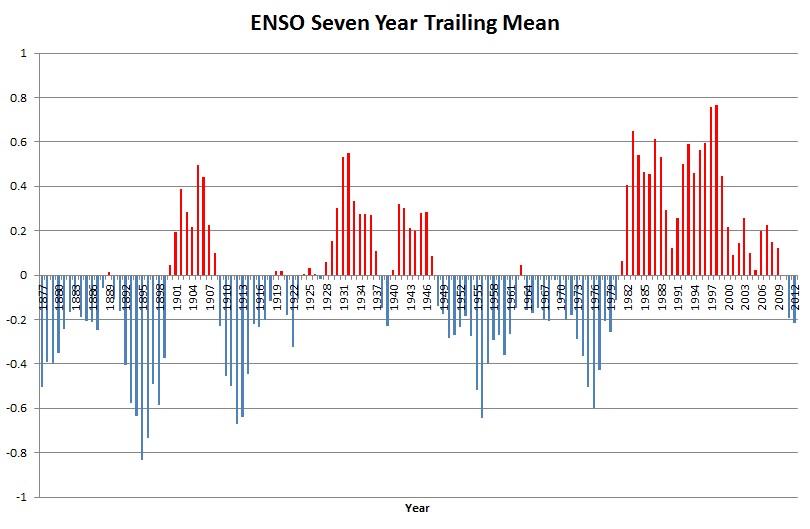 www.sciencenews.org/view/download/id/37739/name/CHILLING_POSSIBILITIES
www.sciencenews.org/view/download/id/37739/name/CHILLING_POSSIBILITIES
Temperatures warmed from 1890 to 1940. (1890 was the lowest ENSO on record.) They cooled from 1940 to 1975. They warmed from 1975 to 1998. (1998 was the highest ENSO on record.) They have cooled since 1998.
MEI.ext timeseries from Dec/Jan 1871 through Nov/Dec 2005
MEI timeseries from Dec/Jan 1940/50 up to the present
Does anyone doubt that El Nino years are warm, and La Nina years are cold? Hansen prays every night to Gaia for an El Nino. Climate science is dominated by complete morons.



Steven – Bob Tisdale has a great YouTube video out on ENSO and Shows how CO2 based models have been wrong in predicting SST.
http://www.youtube.com/watch?feature=player_embedded&v=CM7IUkvT_Zg
To me the most damning thing about the video, is that the models that are used as proof, do not reflect reality. Model driven drivel, turtles all the way down.
World’s most northerly lake comes back to life
“Kaffeklubben Sø, the world’s most northerly lake, was entombed beneath a near-permanent layer of ice some 2400 years ago. Now it is beginning to thaw – and some of the organisms that disappeared from its waters are beginning to return. The finding is the latest evidence that warmer temperatures in polar regions can result in rapid ecological changes.”
“The lake formed about 3500 years ago when local precipitation increased, says Perren. A few species of silica-shelled algae called diatoms lived in the young lake, but their populations declined as regional temperatures cooled, and they vanished entirely 2400 years ago.”
http://www.newscientist.com/article/dn22337-worlds-most-northerly-lake-comes-back-to-life.html
So 3500 years ago it must have been warmer for at least 1100 years.
Will Global Warming Make Scientist’s Brains Work Even Slower?
The heat is missing from oceans;
The heat is missing from the upper troposphere.
The clouds do not behave as predicted.
The models can not predict the short term, the regional, or the long term.
The models do not deduce the past climate from current data.
How could we believe that models can predict the future?
The models didn’t correctly predict changes in outgoing radiation, or the humidity and the upper troposphere temperature trends.
Models can’t predict local or regional patterns, no chance with seasonal effects.
Modelers do compute, to laughable levels of spurious precision, erroneous micro-estimates and claim to produce an accurate macro global forecast. (Hurricanes, droughts, floods, etc…)
An important fact is that the ocean heat content has barely increased since 2003 (may have actually decreased) – no model shows this!
Nearly all the warming happened in a step change in 1977, yet CO2 has been rising continuously, and utterly in step with increases in population only!
Oops – change
Nearly all the warming happened in a step change in 1977, yet CO2 has been rising continuously, and utterly in step with increases in population only!
to
Nearly all the warming happened in a step change in 1977, yet CO2 has been rising continuously, and utterly in step with increases in human population only!
And if any pedant is luring there – I have zero qualification in total last time I checked.
I think you’ll find that temperatures control ENSO through the magic of CO2 and model adjustment.
(/sarc in case anyone needs it)
Except ENSO has no long term trend… However neither do extreme weather events and that apparently hasn’t stopped the claims from flying around….
Will Nitschke says: “Except ENSO has no long term trend…”
ENSO was biased towards El Nino from the mid-1970s to the mid-2000s.
From the introduction on my book:
The strength of ENSO phases, along with how often they happen and how long they persist, determine how much heat is released by the tropical Pacific into the atmosphere and how much warm water is transported by ocean currents from the tropics toward the poles. During a multidecadal period when El Niño events dominate (a period when El Niño events are stronger, when they occur more often and when they last longer than La Niña events), more heat than normal is released from the tropical Pacific and more warm water than normal is transported by ocean currents toward the poles—with that warm water releasing heat to the atmosphere along the way. As a result, global sea surface and land surface temperatures warm during multidecadal periods when El Niño events dominate. They have to. There’s no way they cannot warm. Conversely, global temperatures cool during multidecadal periods when La Niña events are stronger, last longer and occur more often than El Niño events. That makes sense too because the tropical Pacific is releasing less heat and redistributing less warm water than normal then.
The introduction is included in the Preview here:
http://bobtisdale.files.wordpress.com/2012/09/preview-of-who-turned-on-the-heat-v2.pdf
And the book is discussed here:
http://bobtisdale.wordpress.com/2012/09/03/everything-you-every-wanted-to-know-about-el-nino-and-la-nina-2/
In your view is there a long term trend now that more data has been added to the data set in the last decade, if the entire data set is considered?
Yes the CO2 enters the oceans, in fact its the cause of 93.4% of the warming on Earth.
Remarkably, this defies physics becasue greenhouse gases cannot penetrate the oceans, unlike the sun, where the energy can reach down 150 metres.
The only thing CO2 does is infiltrate into these morons minds and makes them more stupid than they already are.
Greenhouse gases do penetrate the oceans; they absorb and outgas subject to temperature. But maybe you mean heat, which they release and absorb as well.